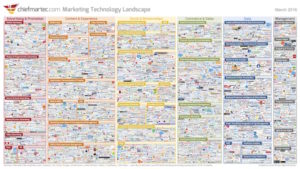
by malterio | Nov 10, 2017 | Digital Marking
Fact: Statistics from the 2017 Marketing Technology Landscape. There are now 5,381 solutions on the graphic, 39% more than last year. http://bit.ly/2yQx8V4
Fact: Marketing technology landscape is 32 times bigger than 10 years ago. http://bit.ly/2xAvDGd
It is not about one system, one platform … it is about the companies org structure, technology skills and competencies, budget, goals and mostly, willingness to accept risk and change.
Let me help you through the software pile to identify a plan to adopt a marketing stack that meets your needs. hybrid-marketer.com
by malterio | Dec 29, 2016 | Digital Marking, Health
I am a podcast junkie and continually striving to learn and understand. During my daily walks, while driving to visit my family and every night as I prepare for sleep.
I listen to most listed below every day. Some of these publish weekly and some daily.
*This is not a paid promotion page. I am not paid for any clicks nor subscribing to these podcasts.
Click Here to find out more about me

by malterio | Nov 26, 2016 | Digital Marking, Marketing Automation, Marketing Operations

The Tech Savvy Marketer will prevail. Marketing Technology Landscape – 3,874 marketing technology solutions on a single slide (March 2015). Three times as many from 2 years prior. This is why knowing ‘the’ single platform chosen by your company is not as relevant. But knowing a few in each category is necessary to ensure you don’t become an obsolete marketer. You need to be continually immersed in it and maintain your own education. Businesses need to invest in marketers education and not pay less as the trend appears to be going.
Thank you @chiefmartec and @marketingbookpodcast for pointing to this fact
http://chiefmartec.com/2016/03/marketing-technology-landscape-supergraphic-2016/
Click Here to find out more about me
by malterio | Nov 14, 2016 | Digital Marking, Marketing Automation
Today, I had a call with a potential client. During the discovery session I found they are in the middle of a marketing automation and sales force implementation, and not much experience doing so. Knowing many consultants and employees implementing these platforms don’t know the “get-cha” items, I offered the following list of items to address sooner rather than later. There are tons of high level articles on how to administer requirement gathering and implement these platforms that you can find on the internet. And as I professed on my blog objective, I will not post such high level information. So here are a few deep dive items that can “get-cha” if you don’t think and address them up front.
Feel free to call me for a deep dive into any of these items.
1. Understand clearly the definitions and native process and assumptions for prospect, customer and lead. Most MA and SFA platforms assume natively that once a customer, never a lead again. That means that if the MA creates a “lead” which turns into an Opp and Account, it can never be a lead again. (ouch) Thus, if you have multi products or other reasons for lead assignment (customer sales call requested), you should understand the behavior in each system. Create your user customer experience and think about how the MA/SFA will collect, integrate, assign (or not) each piece of information from the ‘object’ and ‘field level’.
2. Decide before you launch who and if someone can delete or dedup (merge) in either system. Last year I found that ‘sales’ people were deleting leads because they wanted to clean up their ‘view’ and saw no potential (oop’s), and deleting contacts because they were no longer with the company. Typically these systems are bidirectionally synched and deleting or merging in either or both systems can result in 1) incorrect reporting, 2) integration errors, 3) new lead creation, 4) legal permission issues (opt-out) and much more. I typically ask clients to restrict this until we sit down and review integration functionality capability (dedup/merge replication), pro’s and con’s.
3. Decide immediately and typically before data architectural design and configuration, what you want to report on. Often, my clients build the platform(s) natively which don’t allow for reporting on 1) pipeline stage, 2) lead age, 3) multi-product dimensions, 4) competitor/employee exclusions, 5) separation of partners, customers and prospects, 6) campaign vs medium vs source vs medium vs channel.
4. What are the data relationships you need to facilitate sales 360 degree view? This can be “family members”, businesses with employees, company parent/child relationships and much more. Thinking about your data architecture and system limitations/capabilities are key.
5. Where in the world are your prospects/customers and what are the global compliance regulations? This is more so key for those outside the USA. A few questions are: do I need to understand the difference between an opt-in vs ‘blank’ (not knowing if they opted in), Am I required to explicitly ask for emailing permission or can I do it implicitly? How do I unsubscribe across duplicates (which value survives)? What occurs with merging of same person but different email addresses? Do I have a query template that includes each countries compliance rules or does my system have automated rules that may not match my custom permission values? What if someone opt’s back in…does it overwrite that in the other system?
6. How to you handle sales call inquiries? You should think about all the inbound data entry points. How do you score to ensure those inquiries make it to sales or inside tele teams? Do you want inbound sales calls flagged so it scores better. What occurs after returned call is made? It is my experience that this is often missed in use case development. Typically a MAP will not create a lead if a lead already exists or if it is a customer and thus, building out the use case and diagramming what occurs to ensure that someone is notified that a call has been requested is absolutely key.
7. Document and review slowly the data integration rules for each and every field. Do you want that field from the MAP or SFA system to insert the new value, overwrite, update or append. This applies to forms and all data entry points as well – think about the action of the new information you are collecting or transferring and the step in the buyer’s journey. I often remind people that during the beginning of the buyer’s journey, especially if too much is gated, people tend to add invalid form data. Think about each data entry point, where it is in the journey and how the information should be added to your systems.
8. How to identify those that should never be a lead and/or not receive your marketing material? Do you need a means to identify “reject” (not create a lead) contacts or leads such as vendors/employees who complete forms during testing processes or competitors attempting to get your information? Setting up a data field, flagging rules and then every report and query includes an exclude or include statement is the easy solution. I have seen clients making business decisions about form templates and campaign success based on metrics that included 80% employee’s who completed the forms for the purpose to obtain the content or testing purposes. It is key not only to filter out these people but monitor these ‘rejected’ actors as it may indicate a need for a more robust sales enablement process.
9. How are leads, inbound calls, partners, competitors, vendors and accounts assigned and routed. Do you want people from Europe to be assigned to a specific queue or person? Do you not want to create a lead for a competitor? Do you want to assign partners differently than prospects and customers? Are your competitors also technology partners? An example might be by geography which means you have a means to collect, append or deduce that geography (ex: state or country) up front on all data entry points if distribution is going to occur. I often find clients that only collect email and yet they want to report or assign a lead to their rep by geography. There are many opportunities including appending based on area code, appending, catch all queues, gating for info (progressive profiling) and more.
10. Data Entry Points – Data Entry Points – Data Entry Points. Develop carefully, understand, gate, monitor and have template documents for every data entry point up front. In general, the less data entry points, the easier to monitor and control. What are data entry points? Any means that data can get or be modified into your system. This includes, Offline Import, Forms, Software integrations, MDM or data warehouse integrations, manual intervention (marketing/sales/administers) etc. It is absolutely critical that you think about the standard field values, minimum requirements for each platform, create processes and super users who are detailed orientated.
Marketing automation is not an implement out of the box nor a set-it-and-forget-it piece of software, at least not if you want it to transform your business. These and other “get-cha” items can be managed if you follow a proper requirements, design and implementation plan. Don’t rush your implementation as going back later can cost you more than spending the time up front. For the most successful implementation, make sure your plan is structured to think about the “get-cha” items, get Sales involved, and employ the best and brightest minds.
Click Here to find out more about me.
by malterio | Oct 3, 2016 | Digital Marking, Social Media
As a marketer, we can’t ignore the #Hashtag. We must know how to strategically implement these tagged topics so they can expand our content reach, amplify your brand, target our market appropriately, what is trending, get us found easily, improve our SEO, and much much more.
As many people use hashtags in their posts without knowing if people are actually searching for them, I did some research and found Hashtagify (love them)! They appear to solve the problem we marketers have by putting real data behind the hashtags we plan on using. You can search by hashtag’s to see if it’s popular, who are top influencers and even check on your competitors. hashtagify.me I just created a free account and I am very pleased at the amount of information available. Cudos!

by malterio | Aug 29, 2016 | Digital Marking, Marketing Operations
Welcome to my marketing blog. I am a multi-disciplinary and modern marketer with over 20 years of experience. Herein are my thoughts and perspectives that will dig deeper than the 1000 foot articles that anyone can find on the internet. My goal is to further share and educate marketers on those items that they can’t find in textbooks as marketing is an ever changing and evolving career.





